Breaking up is hard to do, but sometimes you’ve got to give up on an avocado tree. Last week, I gave up on three. I’ll show you which and I’ll tell you why.
Little GEM with gopher damage
The first was the GEM shown above, which hadn’t even been in the ground for a year, but early in its life was attacked by a gopher. I killed the gopher immediately after the attack, but small avocado trees cannot recover from much damage to their roots.
I have observed this in numerous other young avocado trees. Unless the damage is only very slight, then even after a few years of good care they never totally rebound. (See, for example, the Sharwil that I planted when my middle son was born.)
Ever since the gopher attack, this GEM tree did not grow as well as it should have. How could I judge that? I have a few other GEM trees that I planted at the same time. Here’s one of the others:
Signs of health on the above tree compared to the damaged one: the mature leaves are larger and deeper green; bronze new leaves are emerging from branch tips. And then, when I scratch away mulch I can find many roots. I could scarcely find any roots, however, on the damaged tree.
It was helpful to have this other GEM tree to refer to. It showed me that the gopher damage was having lasting consequences on the other one, and rather than coddling that sick little thing I ought to cut it down and replant.
Nabal with a bad rootstock
The second tree I cut down was a Nabal that I’d planted in October 2018. On planting day, the tree had slightly pale leaves.
In the past, I’d seen avocado trees green up after planting, and this Nabal did green up temporarily the following spring. But then its leaves again became pale green and blotchy yellow.
This was especially concerning on a Nabal tree, which is a variety of avocado that normally has particularly large and attractive leaves.
The Nabal was on Zutano seedling rootstock. I had planted a few other avocado trees at the same time as this Nabal, and they were also on Zutano seedling rootstocks. They looked and grew fine. However, avocado seeds are genetically variable and so are seedling rootstocks. Judging by the performance of this Nabal, my guess is that it was grafted onto a seed that had bad genes. This happens. (See my post, “Avocado rootstocks: What do they matter?”)
Two and a half years is long enough to see that this tree will never thrive in this location. It may have been possible to amend the soil (e.g. lower pH) in order to make the tree happier, but since the trees next door are doing fine without such amendments, I’d rather cut down the Nabal and replant on a better rootstock.
Holiday with low fruit production
Then there was the Holiday that was five years old and had yet to give a real harvest. It was partly my fault; I certainly could have cared for the tree better. I planted it near a large live oak tree that sucked away some of the water I gave to the Holiday.
Regardless of who is to blame — the Holiday, me, the oak — the tree was not thriving in this location and my water could be spent more profitably elsewhere. I know this for sure because the Pinkerton right next to the Holiday is the same age and has had small crops the past two years. Today it is carrying 33 avocados while the Holiday was only carrying 4.
After cutting my losses with the Holiday, I can divert the water that I had been using on it to other trees in better locations (and more productive varieties). (See my profile of the Holiday variety here.)
Other poor locations for avocados to avoid, if possible, are spots on top of a hill that are too windy (lots of fruit will get knocked off and the trees will need more water); spots that are too low and cold in winter (subjecting them to frost damage and poorer pollination); and spots where the soil has slow drainage, making the trees vulnerable to root rot.
Reasons to cut down avocado trees
In summary, here are four good reasons to give up on an avocado tree:
1. The tree is young (less than two years old) and it has been damaged badly, such as by a gopher, severe underwatering, or severe sunburn. (“How to water a newly planted avocado tree.”)
2. The tree gets bad leaf burn every fall or the leaves throughout the year look blotchy or small or sparse — but you are providing enough water and soil fertility. (See more at “Reading avocado leaves” and “How much and how often to water avocado trees” and “Fertilizing avocado trees.”)
3. The tree is in a poor location (as described above) and you have a better location available. (Ben Faber, farm advisor in Ventura and Santa Barbara Counties, goes into detail about this in his recent presentation for the August 2021 Seminar of the California Avocado Society. See 32 minutes into this video.)
4. The tree doesn’t give you many avocados, and you have realistic expectations. (See “How long until an avocado tree fruits.”)
These are “good” reasons to cut down such trees because you deserve better, and you can probably achieve better.
Replanting
Can you plant a new avocado tree where another failed? Probably. It depends on why the first tree failed, as well as whether you are willing to improve conditions for the next tree.
For example, I can replant where that little GEM was attacked by a gopher. I ought to first crush all gopher tunnels in the area, and it might also be wise to plant the new tree in a gopher basket.
With the Nabal on a bad rootstock, I should have no problem planting a new tree on a better rootstock in that very spot. The other avocado trees surrounding it which are thriving show that it’s unlikely that the general area is inhospitable to avocados.
In contrast, as for the Holiday, I would do better abandoning that spot. The nearby oak tree gives such strong root competition there that establishing a wimpy tree like a young avocado will always be challenging. It can be done; I do have other avocado trees producing near the oak, but they are not as productive as other trees farther from the oak, and they require a lot more water than my other avocado trees (because the oak is stealing much of it).
I’ve seen young avocado trees near large trees in other yards and groves that struggle like the Holiday. And I’ve noticed that three strategies help: adding extra water, especially with a broader wetting pattern; pruning the roots of the large tree with a shovel or something similar; and pruning the canopy of the large tree so that it needs less water.
Yet the only true solution to this arrangement is to either plant the avocado farther from the large tree or entirely cut down the large tree.
We might have to cull a few mistake trees until we get to that happy, productive avocado tree. I sure have! But those mistake trees are only full losses if we don’t use them as lessons.
Here’s a video I made about cutting down the GEM and Nabal:
All of my Yard Posts are listed HERE

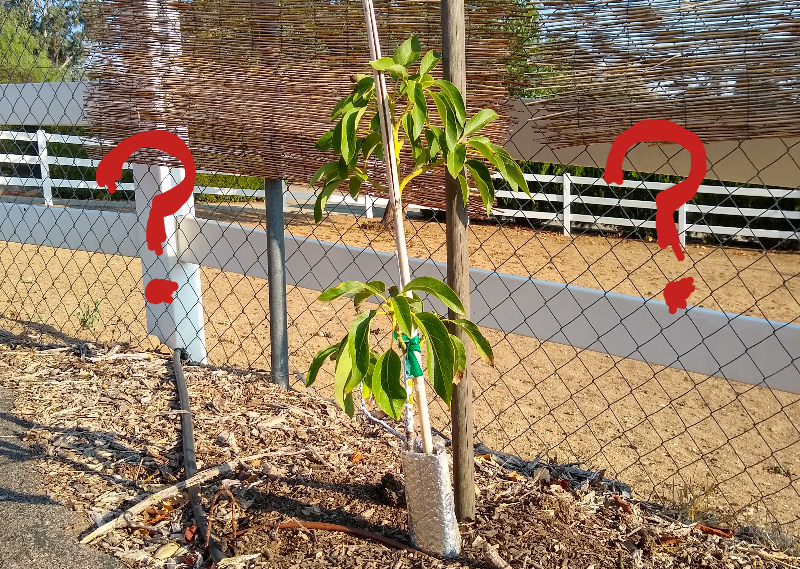
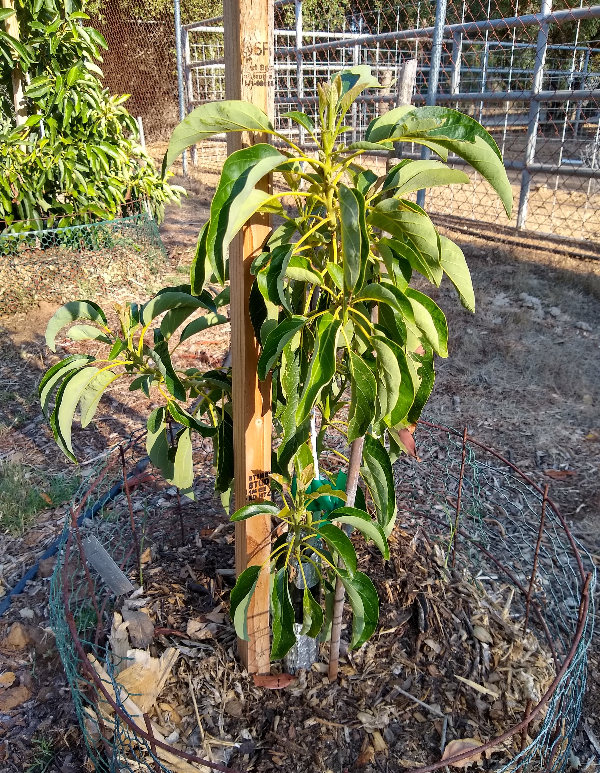
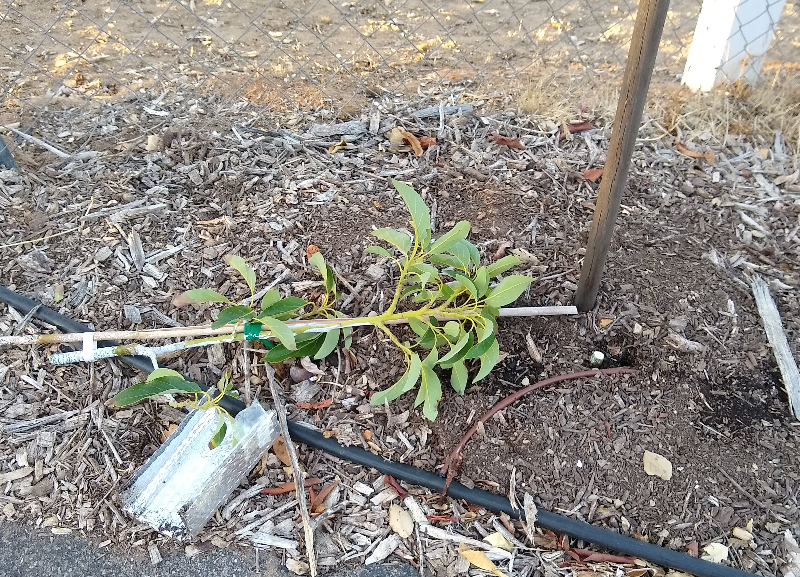
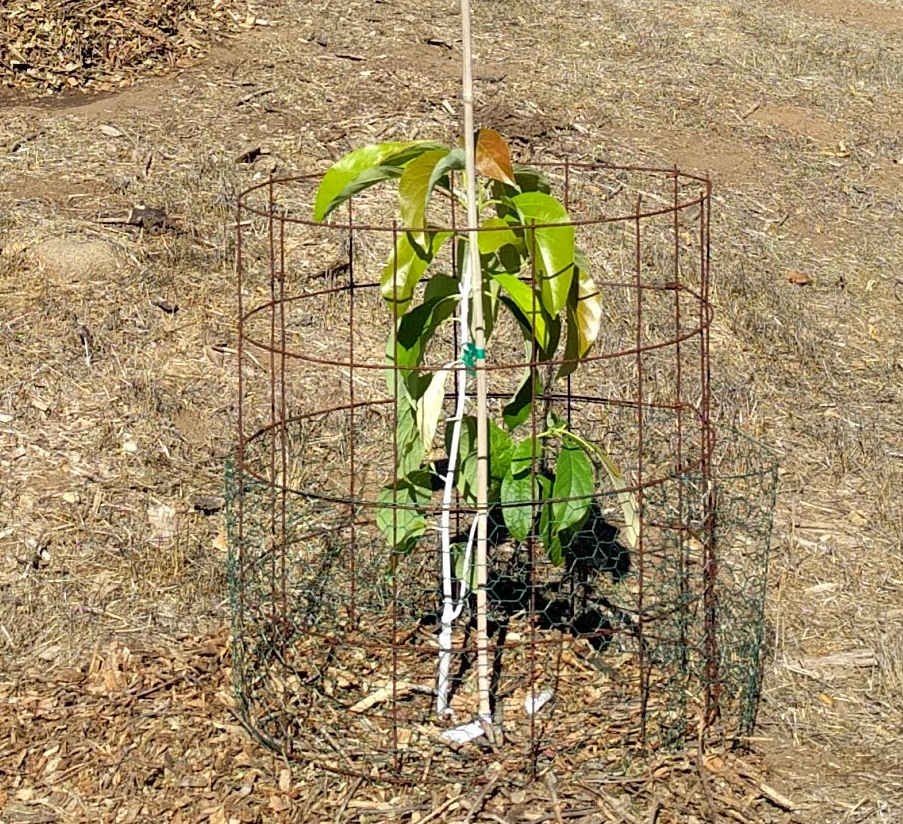
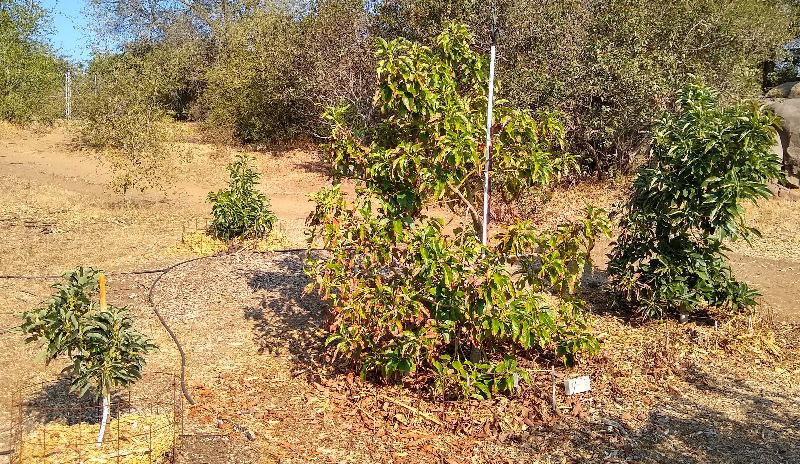
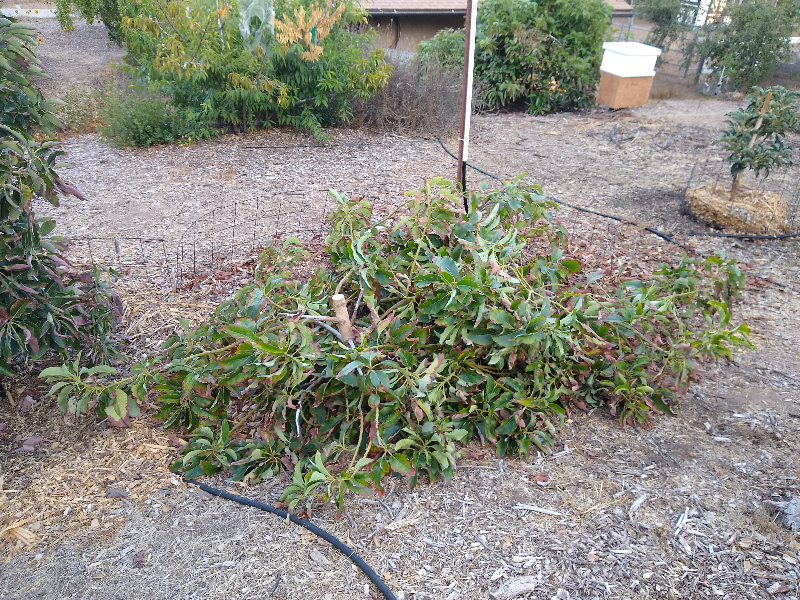
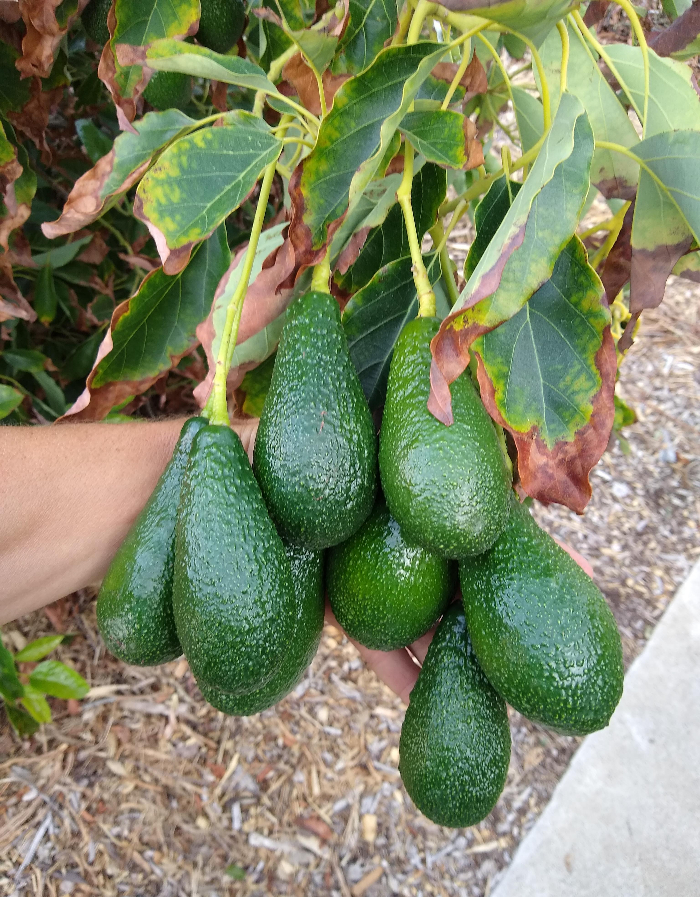



Thank you for this. I’m debating on giving up on my Wurtz. It’s growing well, but the limbs have always been really droopy and I’m not getting any fruit (planted it about 3 years ago).
I’m only hesitant because it’s my only avocado and I’d hate to start over.
Rather than cutting down “stump” it and graft on better variety. There are a lot of videos on you tube on grafting. This way you will get fruit soon and grafting although frustrating can be fun and bring good results.
I also have a wurts here in Kau, Big Island. I planted it about a year ago, it was 3 feet tall with a couple of branches. It now has grown well, about 5 feet tall and it too is droopy. I have seen photos of wurts trees with some branches on the ground with tons of fruit. It bloomed in Feb. of this year, and I removed all the blooms except one cluster. That cluster developed 1 avocado and I am going to harvest it today!!
I would not give up yet on the wurts, you might be surprised.
What’s my fuerte’s problem? Planted a fuerte several years ago on the coast (Solana Beach)and the tree looks great, gets plenty of water, fertilizer and love. Each spring it has tons of blossom/flowers but we’ve never been rewarded with any fruit. Not even a nugget of an avocado. Is it a pollination issue?
How much is “several years” and how much fertilizer of what type? Too much nitrogen can result in growth at the expense of fruit production. It’s getting enough sun?
Hi Susan,
Are you sure you’re not growing my Fuerte tree? I’m in the same boat. See my profile of Fuerte for details: https://gregalder.com/yardposts/the-fuerte-avocado-tree-a-profile/
I would cut it down and replace the tree, which is sort of what I’ve done with mine (I’ve grafted many other varieties onto the stock).
Thanks for this post. I have 5 avocado trees here in Kau on the big island. One I planted from a seedling five rears ago that was given to me. As a tree, it has done amazingly well. It is now 20 feet tall and 10 feet is diameter. It has bloomed 3 years in a row, usually mid February. This is the first year it set any fruit but now has only 2 avocados . They are round, look like Reed to me but who knows.
I would like to cut this tree back, and graft on a Reed scion and maybe a Fuerte. Do you have an idea of the best time to graft here in Hawaii? I have tried contacting the ag dept. at the UofH in Hilo, but have had no response. My huge 30 year Reed is now putting out new growth so maybe now would be good??
I do enjoy your posts!!
Hi Dave,
I don’t know when the best time to graft in Hawaii is, but a couple things that determine a good time to graft in California are the stage of the scion wood (ideally, you want scion wood that is not actively growing and feels rubbery; you want it to have fat but dormant buds) and the weather (not too hot like mid-summer and not so cold that there’s a chance of frost).
Cool to hear you enjoy the posts. I hope to get over to visit the Big Island in the next couple years; I’ve never been.
Long term lurker, first time comment, so let me begin by thanking you Greg for all of your time, energy, and insights here. Your advice and encouragement have effects far beyond what we read in the comments.
With regards to location/siting for a planting: do you know how far a coast live oak root system extends to compete with an avocado or citrus? I have a large oak, maybe 20″ diameter trunk and 50′ canopy, which is about 25′ from a site I’d like to plant an Kona Sharwil avocado. I have good draining soil, but a previous Nimlioh planting failed, and I’m concerned that I’m courting disaster. The canopy of the oak will provide for some afternoon shade (possibly a benefit here in hot/dry Chatsworth), but could be pruned back as needed to allow space for the avocado.
This spring, I dug out the hole for planting and did see roots extending through the area. There are a Rhus Ovata, Ceanothus and a Fremontia closer by, and were a few oak seedlings (since eliminated). My strategy was to open the hole wider than necessary, and then leave it to dry out over the summer. Those shrubs may have been set back and I could eliminate them, but the big oak I won’t sacrifice. I have a Bearss Lime about 15′ to the north of the oak that has been holding its own for years despite the shade. Hoping to plant when the weather cools just a bit.
Thanks Greg!
Hi Doug,
Thanks for you kind comments. Your situation is so familiar to me, and I’d love for you to make fewer mistakes than I have.
I just walked off the trees I have planted near a large oak in my yard (which sounds about the same size as your oak). There is a Hass tree that’s eight years old and does OK, and it is 18 paces (about 45 feet) to the east of the oak’s trunk. There is a Gwen that is about ten feet closer to the oak on its east side and it struggles more than the Hass.
There are also some avocados planted to the south of the oak. These trees struggle the most; I think it’s because they get more intense sunlight throughout the year but don’t get any shade from the oak while still losing some of their water to the oak roots. There is a Sharwil that is about three years old and 14 paces (about 35 feet) to the oak’s south, and it does OK. However, the avocado trees that I’ve planted closer to the oak have all struggled more.
My two main strategies for planting avocados in the vicinity of the oak are to prune the oak roots with a shovel at planting time a few feet outside the planting hole, and to water the young tree broadly (not with a single dripper over the rootball as will satisfy a tree in a different area, but with at least three drippers or a micro-sprayer that wets a broader area).
I’ve noticed that I also have to do this when avocado trees are near other native plants, such as sumacs. So you might need to do the same if your tree is near the ceanothus etc.
And just last month I paid some tree trimmers to prune off the lowest branches of the oak. I wanted to reduce its canopy size a bit (which will reduce its water needs) and reduce its shade slightly.
Like you, I will not remove my oak. It’s a beautiful tree that provides so many benefits.
Help! I have a large 7-8 year old avocado tree that produces a lot of tiny 1/2” fruit which then fall to the ground. Suggestions?
Hi Vince,
Check out this post for ideas: https://gregalder.com/yardposts/avocado-fruit-drop-why-when-how-many/
Hiii! I live near san antonio, TX on 2 acres of land. I need to find some more mature avocado trees for zone 8- closer to production age- where we have a constant supply all year long. We dont want to wait years so the problem is we cant find, and dont really know how/where, to find trees closer to production age near us so far. Can you help us locate a seller? Are grafted trees from sellers online- ebay etsy- a good choice? Many of them have sold hundreds of trees over years so I figure its a nursery. Thank you.
Hi Teneca,
Check out this post for suggestions (although it’s very California oriented). As you’ll read, the only online seller of avocado trees that I have experience with and whom I can recommend is Four Winds Growers.
https://gregalder.com/yardposts/where-to-buy-an-avocado-tree/
Hi Greg!
I will again day how grateful I am for your expertise and dedication to sharing your knowledge. A huge help!
Quick video of my Hass, planted on a slope, originally from a 24″ box in Feb of this year.
Not sure what to be expecting – and certainly praying that it’s too early to give up in any way. Any thoughts when looking at it?
https://youtu.be/-nREH3uWOhs
Hi Andy,
Cupped leaves are never a problem on an avocado tree. It’s drooping leaves that indicate a problem.
The soil you grabbed looked dry to me. It also looked like a potting mix (not real dirt) and very fast draining.
The soil near the tree (to the right in the video) looked like it was wet and like it had a high clay content (slick and cracked).
My thoughts on watering in this situation are that you need to make sure that you apply the water right by the trunk, directly over the potting soil where the tree’s roots were when first planted. Surely, if you planted in February, the tree will have pushed some roots into the surrounding native dirt through the summer, but most of its roots will still be in that original ball at this point so you must keep it moist. Never let that area dry out. Also keep in mind that clayey soil has an especially strong ability to suck moisture away from coarse stuff like that potting mix.
The tree being on that terrace behind the retaining bricks mean that it will need more frequent watering than if it were down on flat ground. You’re right on that. Don’t hesitate to water more frequently, especially if the slope faces south.
Greg, I might have made a big mistake. I planted Society Garlic around the base of my avocado trees to ward off varmints.
The mistake I believe is that the plants are competing with the tree. Can I feed/water more, or as the avocado gets established, it will work out. Trying to decide whether to rip out the plants or leave them. Worried it will kill the avocado.
How sensitive are the trees to having plants near their base? I have let grass grow etc. To allow water into our clay soil. I also mulch.
Hi Annette,
Newly planted avocado trees are wimps. It’s best if they have no competition for their first year at least.
That being said, they can handle certain plants near them as long as you increase the water accordingly. I’ve grown many melons and vining squash and potatoes near young avocados without a problem.
However, completely surrounding the tree with grass or any other plant might be too much. I’ve seen many avocado trees planted into lawns that struggle, for example — even when ample water is applied.
In your case, as long as you keep the grass at least a couple feet away from the trunk of the tree on all sides, and you only let the society garlic grow on one side, and you keep a thick mulch, and you water sufficiently, then all parties will probably be able to get along.
Hi Greg ^_^
I am in need of your expertise again.
My Sharwil is going to be 3 yrs old in Feb 2022. My problem is the leaves started to burn from bottom up a couple months ago. Then it has black dots like mold on the burn parts. I assume from los angeles crazy weather and humidity. I thought it was salt in the water so I drip water for 8 hours twice. Now it seems to start flowering but the leave burns is 50% of the tree already. Please tell me what else I can do. I don’t know if it’s normal or if it’s sick.
I have photos but I don’t know how to add on here.
Thank you Greg
Hi Greg,
I could really use your help! I am growing a few avocado trees, and this is my first time growing them. My little plant is perhaps just over a foot tall now and a few months old. However, I noticed that at one point it stopped growing vertically and started (what looked like) rotting from the top down (it’s blackened). All of the leaves that grew off of the main stem had withered and fallen off, but it started to also grow separate stems off the main stem around the same time the top started to die. I am not sure what to do. The rot keeps progressing from the top of the main stem and moving downward, and I am afraid it will take the entire plant eventually. I don’t water it frequently, but I feel that maybe I’m still watering it too much. I’ve attached some pictures so you can see. I went through your blog (with a lot of helpful information!) but haven’t found much regarding stem rot intervention. Is there anything that I can do to save the plant? Should I cut off the blackened portion of the stem? I would greatly appreciate any help and advice you can give.
Thank you very much,
Brandon
Sounds like root rot to me.
Monterey Agri-Fos Disease Control Fungicide is what I use.
Read instructions before you buy, it is expensive.
“more avocado trees are killed with water hoses than chainsaws”
Hi Greg,
I think its time to give up on my Hass. I planted it in the spring of 2018, from a 15 gallon from Maddock, they said it was 4-5 years old at the time I planted it, along with a Reed and Fuerte side by side. So they would all be close to 8-9 years old by now. The Reed has made some fruit for me, the Fuerte didn’t flower its first two years but set a crop last year and has a lot of flowers right now, but the poor Hass has never shot up a single flower. It got hit hard by the heat wave in 2018 and then suffered a lot from the frost in Feb 2020. It’s much smaller than the Reed and Fuerte despite being watered the same and the same sun profile. Finally I’ve since planted 5 more trees – 2 Gems, a Gwen, Pinkerton and Lamb – and all of them have outgrown the Hass and all of them have made fruit. The Hass is growing, but still hasn’t flowered at all this Spring (lots of new leave shoots but not a single flower). I’ll give it to the end of the Spring before cutting it down.
Hoping to avoid the same issue, is it possible that Hass just doesn’t like my microclimate? I’m in the Gird Valley in Fallbrook, I get a little more cold and a lot more heat than surrounding areas of Fallbrook which obviously produce a jillion Hass avocados. Or is it more likely that my tree just had too much stress when it was young? Should I try Hass again in that spot, or look for something maybe more hearty? The Pinkerton 15 feet away from it has a huge amount of flowers and some really giant fruit ready to harvest. Maybe another B type instead? Bacon? Sharwill? Thoughts?
Thanks as always… I’m making notes of all my Avo’s progress in the Avo calendar you sent me last year:)
/Dave
Hi Dave,
Thanks for the detailed report. I would suspect that the problem is not with the Hass variety but rather either that specific tree or the exact spot where the tree is planted.
I have a couple “dead spots” in my yard where multiple avocado trees have struggled until I removed them whereas only ten or twenty feet away other avocado trees are doing fine. I finally planted one of these dead spots with a pluot, which is tougher than an avocado, and the pluot is doing well but not as well as pluots in other spots. There’s something in the soil right there but I don’t know exactly what.
But also your particular Hass tree could be a weakling, probably because of an issue with its roots.
If I were you and I wanted to try another Hass, I would go for another one from Maddock, hoping that luck will be with you on the next seedling rootstock. Or try one on a known, tough clonal rootstock such as Dusa or Toro Canyon from Subtropica.
Either way, I think you’ve given that Hass enough time and you ought to cut your losses.
Hi Greg, found your site while searching for help for my 25+ year old Whitsell. I live on the border of LA and Orange county. Lots of great articles. Seeing that you’re in SD county, lots of your information is pretty relevant to me.
My issue, that’s been going on for the past couple of years, is rodents climbing up my avocado tree and gnawing on the fruit. Wondering if you have any deterrent suggestions?
Much appreciated.
Hi Darrell,
How do you like those Whitsells? Check out this post about dealing with squirrels: https://gregalder.com/yardposts/dealing-with-squirrels-in-a-food-garden/
If you’re dealing with rats, some of the same methods will work, but also you should consider a good farm cat.
Quick update…
That Hass I contemplated cutting down last spring, it produced two large fruit which I just harvested today. However, the tree itself has been growing, seems healthy again and right now, it’s got a really large baby fruit set which is the first time its done that for me. So, it gets a stay of execution for now, and I’ll see how this big fruit set develops over the next year.
Ultimately all eight of my trees gave me some fruit this year, a few like both Gems and the Gwen, produced a ton, and I got a nice crop of Fuerte’s back in February as well. Fuertes were my favorite of all the varieties. I love it when a plan comes together.
/Dave
I have a Lamb that hasn’t done well since I planted it four years ago. I’ve decided to give it up to plant another avocado tree. It was attacked by some small animals and never recovered. I when I dug it up today, I thought the roots would be stunted but the root ball is quite extensive and it took me a long time to remove it. My question is, do you remove all of the roots from the original plant before planting another? BTW, my effort is not totally wasted since I get to know the soil under the tree better. I plan to raise the soil and add lots of sand to improve drainage,
My dad grew our avacados tree from a pit 45 years ago. It is producing and doing great central Calif. It is planted between two houses it’s about 30 feet tall
Thanks so much for the information, it’s very helpful to know circumstances to consider to move on from a tree.
In your example of root damage to the young Gem tree, any estimate of what percentage of the rootball would be damaged for you to give up on a young tree? In the case of your Sharwil it sounded like damage to a little more than half the root ball was enough to inflict lasting damage. I recently lost the bottom third of a rootball from a three-gallon sleeve when re-planting a Reed on clonal and am a bit anxious if I need to replace it.
Hi Greg, wondering if you have any success bringing back a young tree from root rot. I have a Pinkerton that has not grown for a year and has lost all its leaves. After treating with hydrogen peroxide/water it seems to now be coming back with new leaves, but is still small (size of 5 gal). I also have a new 5 gal Jim I want to plant as close as possible to the Pinkerton ideally in the same hole – wondering if I should start fresh with a new Pinkerton and plant them in the same hole or somehow try to reposition the existing Pinkerton when I plant the bacon. I have limited space so nowhere to plant the bacon alone. If starting fresh I would try to excavate as much dirt as possible due to the root rot issue.
Hi Steve,
Rotted Reed replaced by 15 gal Gwen in same hole.
Removed dirt 2 feet across and 2 feet down with post hole digger replaced soil with washed plaster sand from home depot.
Treat with:
Monterey Garden Phos Systemic Fungicide previously known as Agri-Fos Systemic Fungicide is very effective in controlling plant diseases such as Pythophthora, downy mildew, pythium, black spot, root rot, anthracnose, and more. It contains mono- and di-potassium salts of phosphorous acid and it functions as both a curative and preventive treatment to plants. It may be applied as a foliar spray, soil drench, by soil incorporation, through basal bark treatment and as a bare root dip. It can be used in trees, turf, ornamentals, in landscapes and interiorscapes, and bedding plants.
Gwen in same hole as Reed, after two years, has ten avos at this moment.
Try this for clay soil
By Julie Frink
1. Place the potted tree where you are planning to plant it.
2. Build up the soil around the pot, up to the level where the stem comes out of the dirt. Tamp the dirt down so it is somewhat firm around the pot. If it is a large pot you can put it into the ground half the depth of the pot.
3. Take the pot out of the dirt mound.
4. Remove the tree from the pot.
5. Put the little tree in the hole in the dirt mound left by the pot.
Little digging is necessary but nice rich dirt for a mound is. When a hole is dug there is a problem of water draining into it (and the root system of the new plant) like a well, or draining out of that area into the surrounding soil, leaching it dry depending on the soil content of the surrounding soil. If you feel better about the process by spading up the ground and making it loose or amending it that would be ok. Many of the new commercial plantings are on berms or raised areas. This has alleviated some of the root rot problems. After planting, all trees settle somewhat so that in several years the trunk area will be lower than when you planted it.
Avocado trees like lots of water but good drainage. They don’t like clean hard dirt under their outstretched branches. They like lots of leaf and wood chip litter to keep their surface roots cool and well nourished. They do not like soil under the tree to be cultivated because it disturbs their surface roots. Most of the avocado feeder roots are in the top few inches of the soil. Avocados do not do well in pots. Very large pots can be used for a few years but that is all. Transplanting from a large pot (like a whisky barrel) is very difficult. Often the root ball falls apart and the tree dies. It is very rare to get good fruit production from a potted avocado tree. It is best to plant from your 1 to 5 gallon potted tree into the ground that the avocado tree will occupy for its entire life.
Don’t fertilize heavily. Too much fertilizer will kill an avocado tree because it has all the delicate feeder roots that are so close to the surface. No fertilizer will not kill a tree. Just the right amount of a very dilute solution of fertilizer will help a tree to be healthy and to grow faster.
If the tree is quite small you might consider protecting it with a tomato cage to keep soccer balls, large birds, children and large dogs from destroying it. Baby trees like shade. Nature has them growing under the limbs of the mother tree. Larger more mature trees like lots of sunshine.